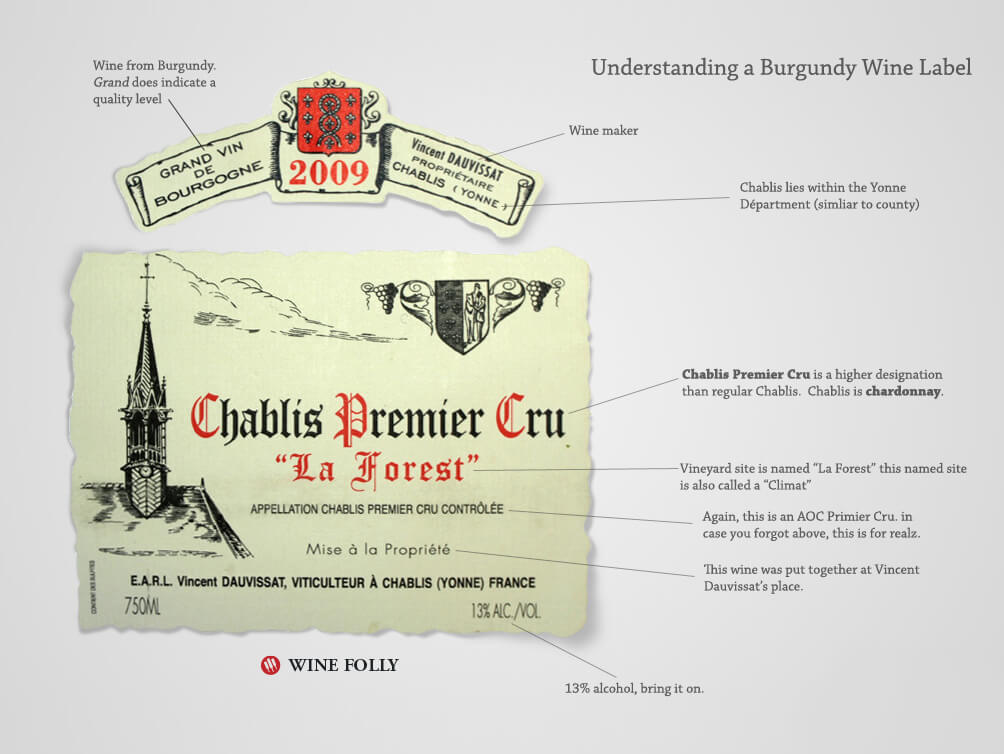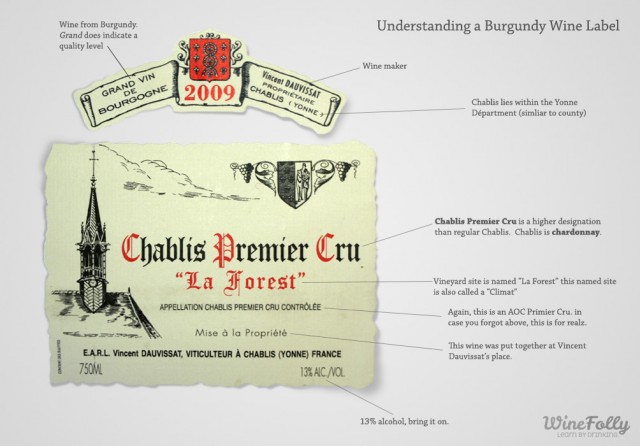Here are some helpful tips (and visuals) on how to read a wine label.
Wine labels have a lot of information on them. Some of it is critical to understanding what is in the bottle, and some of it is just blowing smoke. Here’s a quick guide to help you know what matters, how to spot a bargain, and what to ignore.
How To Read A Wine Label

There are 2 main styles of wine labels commonly found in the stores. A wine identified by its brand name or a wine designated by its appellation credentials. A wine that is labeled by it’s brand will indicate what grapes it’s made of on the front label (whether it be chardonnay or ‘red blend’). A wine that is identified by its appellation credentials relies on the appellation’s quality level rules and regulations to indicate what’s in the bottle. A perfect example of an appellation wine is Chablis: Nowhere on a Chablis label is a mention of chardonnay as the grape, nor that Chablis is typically an unoaked chardonnay.
Understanding a wine label may not always tell you how the wine tastes but it can help you get a better picture of exactly what you are buying.
5 Basic Parts To A Wine Label
- Producer or Name The producer name is either obvious or in small text at the top or the bottom of the label (such as many French wine label examples). This is who made the wine. It’s important to note that some American wine labels that only have a Wine Name (such as Apothic Red) are branded wines from larger wine companies. Apothic Red is a branded wine by E&J Gallo–the producer.
- Region The region indicates from where the grapes were sourced to produce the wine. A wine from a larger (read: more vague) region is typically a value wine whereas a wine from a specific vineyard site often indicates a higher quality regional designation (i.e. “California” vs. “Santa Rita Hills” AVA). If a wine is from a specific vineyard site, that site will be indicated in quotations (i.e. “Les Suchots”) or located right below the region designation (ie Vosne Romanee Les Suchots). Generally, as you narrow the source to a specific site, the quality level becomes more refined and the price increases.
- Variety or Appellation The variety refers to what grape or grapes are used in making the wine–Merlot for example, or CMS Blend (Cab, Merlot, Syrah). Many blends will not reveal the constituent grapes nor the percentage that each makes of the whole. If there is no varietal given, look for the Appellation, which can give you clues to what varietals were used based on the rules governing that region. There are 15 nations with officially regulated appellations, though the strictness of the rules and what matters varies wildly among them.
- Vintage or Non-Vintage (NV) The year that the grapes were harvested is the vintage. The vintage tells a lot about a wine if you are familiar with vintage variations. As a general rule, multi-vintage wines or “NV” wines are lower value wines, because they have the ease of pulling wine from multiple vintages to control the flavor.
- Alcohol by Volume (ABV) The alcohol level actually says a lot about a wine. Many European wine regions only allow their highest quality wines to have 13.5% ABV and above. In America, ABVs can be quite high (up to 17% on some dry wines) and the alcohol level is an indication of how rich/big the wine may taste. Many higher alcohol wines are made from riper grapes and tend to have more fruit forward flavors. Again, this is a generalization and there are exceptions to the rule.

Other Information on a Wine Label
Estate Bottled Wine
Estate Bottled means the wine was grown, produced and bottled on the wine estate. There are negotiant wine producers, such as Georges Deobueof, who purchase both grapes or wine from many locations and bottle them together. These kinds of wines tend to be lower quality (again, a generalization). Estate bottled wines must be grown and produced on the estate where they are from. Here is the term “Estate Bottled” from various countries such as Italy, Germany, France, Spain:
- Mis en Bouteille au Château
- Mis en Bouteille a la Propriete
- Mis en Bouteille au domaine.
- Embotellat a la Propietat (Spain)
- Imbottigliato all’origine (Italy)
- Erzeugerabfüllung (Germany)
Reserve
The indication of Reserve sounds fancy but it doesn’t actually mean anything official. There are no rules to what a reserve wine is and thus this word on a bottle could mean nothing at all. Many small producers use it to indicate their top-tier wines that use the winemaker’s highest quality production wines from the best barrels. Take this indicator with a grain of salt if the wine you’d like to buy seems too good to be true.
Old Vines or Vielles Vins
The use of grapes from older vines typically lends to more concentrated flavors in a wine. However, there are no rules to say how old the old vine must be to get an “Old Vine” designation. Producers use it to help indicate the style of wine they produce. Vines can range from 15 to 115 years that get the tag “Old Vines” on the label. Some wines that are designated “Old Vines” have a blend of young vine grapes and old vine grapes together.
Contains Sulfites
The words “Contains Sulfites” is a label requirement put on all officially imported or domestic wines in the United States. Most grapes actually have sulfur on them in the vineyard and there is a rather loaded debate on whether or not sulfites matter in wine. I like to use this analogy: If you are not sensitive to dried mangos or apricots which have somewhere around 1000-4000 ppm (parts per million) sulfites versus only 300-400 ppm sulfites in a high-sulfite wine, you’ll be fine.
Sources
French Appellation Origin inao.gouv.fr/ pdf guide
Italian Wine Label Information on italianmade.com